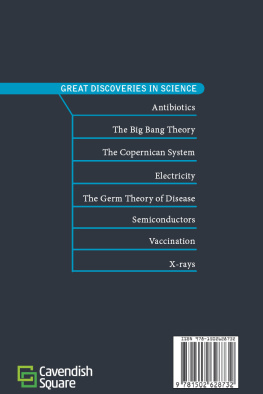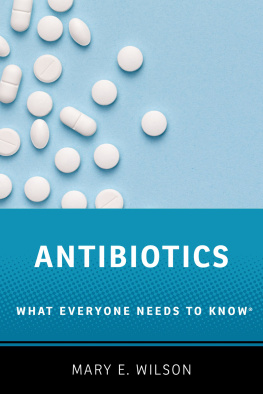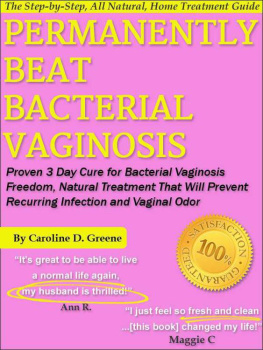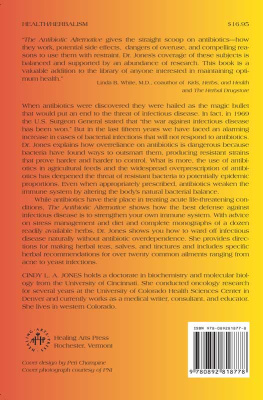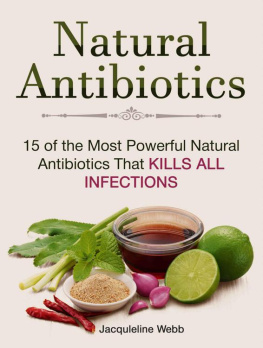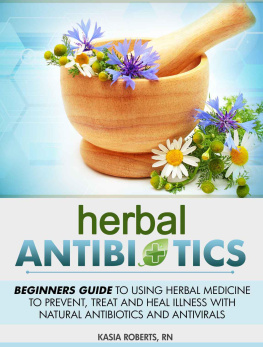Cover illustration: Snapshot of the 70S E. coli ribosome (PDB for 50S is 2WDL; PDB for 30S and tRNAs is 2WDK) bound to three classes of antibiotics. The figure shows RNA (gray) and protein (yellow) components of the ribosome with associated tRNAs shown as blue cartoons and bound antibiotics shown as red space filling spheres. The terpenoid tiamulin Q23 binds to the 23S rRNA at the peptidyltransferase center (PDB 1XBP). The nonribosomal peptide viomycin binds at the interface of the 50S and 30S subunits at the tRNA A site (PDB 4V7L). The thiazolyl peptide thiostrepton binds at the periphery, interacting with a specific pair of 23S rRNA helices and a proline-rich region of the L11 protein subunit (PDB 3CF5). (Image created using PyMOL.)
Copyright 2016 American Society for Microbiology. All rights reserved. No part of this publication may be reproduced or transmitted in whole or in part or reused in any form or by any means, electronic or mechanical, including photocopying and recording, or by any information storage and retrieval system, without permission in writing from the publisher.
Disclaimer: To the best of the publishers knowledge, this publication provides information concerning the subject matter covered that is accurate as of the date of publication. The publisher is not providing legal, medical, or other professional services. Any reference herein to any specific commercial products, procedures, or services by trade name, trademark, manufacturer, or otherwise does not constitute or imply endorsement, recommendation, or favored status by the American Society for Microbiology (ASM). The views and opinions of the author(s) expressed in this publication do not necessarily state or reflect those of ASM, and they shall not be used to advertise or endorse any product.
Library of Congress Cataloging-in-Publication Data
Names: Walsh, Christopher, author. | Wencewicz, Timothy A., author.
Title: Antibiotics : challenges, mechanisms, opportunities / by Christopher T. Walsh and Timothy A. Wencewicz.
Description: Washington, DC : ASM Press, [2016] | ?2016 | Includes bibliographical references and index.
Identifiers: LCCN 2015045498 (print) | LCCN 2015047879 (ebook) | ISBN 9781555819309 (hardcover) | ISBN 9781683673316 (ebook)
Subjects: LCSH: Antibiotics. | Drug resistance in microorganisms.
Classification: LCC RM267 .W358 2016 (print) | LCC RM267 (ebook) | DDC 615.3/29dc23
LC record available at http://lccn.loc.gov/2015045498
All Rights Reserved
Printed in the United States of America
10 9 8 7 6 5 4 3 2 1
Address editorial correspondence to ASM Press, 1752 N St., N.W., Washington, DC 20036-2904, USA
Send orders to ASM Press, P.O. Box 605, Herndon, VA 20172, USA
Phone: 800-546-2416; 703-661-1593
Fax: 703-661-1501
E-mail:
Online: http://www.asmscience.org
Dedicated by CTW to Diana, Allison, Thomas, and Sean.
Dedicated by TAW to Rachel, Grace, and Lucy.
Contents
Preface
Over the past decade, many lines of evidence have come together to emphasize the critical need for new antibiotics to treat bacterial pathogens. These realizations have galvanized the scientific community as well as the global citizenry more generally. Infectious disease groups, government-appointed expert panels, high political officials, and the popular press have noted the prospect of life-threatening bacterial infections triggering global societal crises.
There has been a parallel realization and set of efforts seeking new antiviral treatments as potentially global epidemics arise. Historically, antiviral drugs and antibacterial drugs have been discovered and developed essentially independently with almost no crossover targets or benefits. Viruses tend to be targeted by small molecules that block nucleic acid replication and inhibit proteases needed to cut viral polyproteins into functional subunits; these approaches have not readily been reframed for useful antibacterials. This book then deals only with antibacterial agents, antibiotics, and not antivirals; albeit the need for a contemporary integrated summary is pressing.
The need for next-generation versions of antibiotics is not new. This was the motivation in writing a precursor to this book in 2003: Antibiotics: Actions, Origins, Resistance. It has been true for every class of antibiotic introduced into wide human clinical use since the antibiotic era began in the 1930s that resistant organisms are selected for and eventually become abundant in human infections.
Others have noted, appropriately, the complexity of the cycles of development of antibiotics, development of resistance, and need for new antibiotics. The need for conservation and prolongation of useful lifetimes of the existing antibiotics portfolio has both health and economic consequences. Market incentives over the past 2 decades have been viewed as insufficient for large pharma companies to invest in antibiotics research. Alternatives to traditional small-molecule antibiotics range from vaccines with a preventative role to biologics, whether antibodies or lytic phage treatments, but the use of these therapies has not yet become widespread.
Amid this set of complexities, one constant is that new antibiotics are always needed to deal with waves of resistant bacteria that become inured to any antibiotic class that is widely disseminated for treatment. Given our belief that new classes of antibiotics are acutely needed to fill the front end of the antibiotic cycles, the approach in this monograph, Antibiotics: Challenges, Mechanisms, Opportunities, is chemocentric.
The challenges are many and layered, as noted in passing above, but chief among them is how to find new molecules, whether through the discovery of novel variants from nature or the creativity of synthetic and medicinal chemists. To understand how one might find, discover, and engineer new antibiotic classes, we focus on mechanisms. Three aspects of mechanisms seem relevant. One is to examine the major classes of antibiotics in human clinical use and understand as fully as possible what targets in bacterial cells are hit and what are the bases of selectivity compared to human hosts. A second aspect of mechanism is to understand the molecular bases of resistance as a prelude to next-generation antibiotic design. A third aspect of mechanism is delving into the chemical logic and enzymatic machinery by which producer microbes make the major classes of natural antibiotics. This gives insight into what chemistry is available to producing bacteria and fungi and how it might be modified by chemical and biological engineering approaches to generate optimized antibiotic scaffolds.
The book ends with a section on opportunities, again in the molecular sense, realizing all the many layers of complexities that await even if new molecular treasures are discovered. The approach here is to reexamine bacterial targets that may have been underutilized in past approaches, in part because genomics, proteomics, and metabolomics have given a much more sharply focused picture of bacterial physiology and pathology over the past decade. This section also asks the question: where will new antibiotics come from? Will the dual process of antibiotics from nature and synthetic antimicrobial bullets from human medicinal chemistry continue into the future?
As with any area of therapeutic research and inquiry today, interdisciplinary inputs are required to convert basic scientific observations into clinical candidates with reasonable prospects for safety and efficacy in humans. In the infectious disease arenasantibacterial, antiviral, and antiprotozoalthe confluence of understanding the structure of active molecules and how they interact with affinity and specificity for their microbial targets are a key substratum for success. This volume provides such a starting molecular framework for investigators focused on antibiotics and members of the broader microbiology community.


